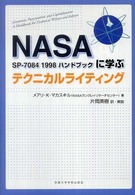- ホーム
- > 洋書
- > 英文書
- > Science / Mathematics
基本説明
Emphasizes the application of plant anatomy and its relevance to modern botanical research. Includes a CD Rom of high quality photographs and scanning electron microscope images giving students access to the microscopic detail of plant structures essential to gaining a real understancding of the subject.
Full Description
This indispensable textbook provides a comprehensive overview of all aspects of plant anatomy and emphasizes the application of plant anatomy and its relevance to modern botanical research. The companion website, 'The Virtual Plant', offers a collection of high quality photographs and scanning electron microscope images giving students access to the microscopic detail of plant structures essential to gaining a real understanding of the subject. Exercises for the laboratory are also included, making this work an indispensable resource for lectures and laboratory classes.
Plant Anatomy is an essential reference for undergraduates taking courses in plant anatomy, applied plant anatomy and plant biology courses; and for researchers and postgraduates in plant sciences.
Contents
Preface. Acknowledgements.
Introduction.
1 Morphology and tissue systems: the integrated plant body.
General background.
Adaptation to aerial growth.
The systems in detail.
2 Meristems and meristematic growth.
Introduction.
Apical meristems.
Lateral meristems.
Practical applications and uses of meristems.
3 The structure of xylem and phloem.
Introduction.
The xylem.
The phloem.
Structure-function relationships in primary and.
secondary vascular tissues.
4 The root.
Introduction.
Epidermis.
Cortex.
Endodermis.
Pericycle.
Vascular system.
Lateral roots.
5 The stem.
Introduction.
Stems - cross-sectional appearance.
Transport phloem within the axial system.
Transport tissue - structural components.
Concluding remarks.
6 The leaf.
Introduction.
Leaf structure.
The epidermis.
The mesophyll.
Strengthening systems in the leaf.
The vascular system.
The phloem.
Specifi cs of the monocotyledonous foliage leaf 111.
Secretory structures.
Concluding remarks.
7 Flowers, fruits and seeds.
Introduction.
Vascularization.
SEM studies.
Palynology.
Embryology.
Seed and fruit histology.
8 Adaptive features.
Introduction.
Mechanical adaptations.
Adaptations to habitat.
Xerophytes.
Mesophytes.
Hydrophytes.
Applications.
9 Economic aspects of applied plant anatomy.
Introduction.
Identifi cation and classification.
Taxonomic application.
Medicinal plants.
Food adulterants and contaminants.
Animal feeding habits.
Wood: present day.
Wood: in archaeology.
Forensic applications.
Palaeobotany.
Postscript.
10 Practical microtechnique.
Safety considerations.
Materials and methods.
Microscopy.
Appendix 1 Selected study material.
Appendix 2 Practical exercises.
Glossary.
Cited references.
Further reading.
Index







